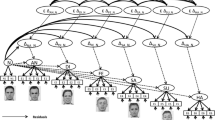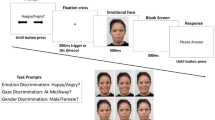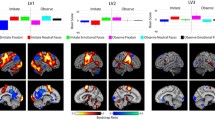Abstract
Neuroimaging evidence suggests that dynamic facial expressions elicit greater activity than static face stimuli in brain structures associated with social cognition, interpreted as greater ecological validity. However, a quantitative meta-analysis of brain activity associated with dynamic facial expressions is lacking. The current study investigated, using three fMRI experiments, activity elicited by (a) dynamic and static happy faces, (b) dynamic and static happy and angry faces, and (c) dynamic faces and dynamic flowers. In addition, using activation likelihood estimate (ALE) meta-analysis, we determined areas concordant across published studies that (a) used dynamic faces and (b) specifically compared dynamic and static emotional faces. The middle temporal gyri (Experiment 1) and superior temporal sulci (STS; Experiment 1 and 2) were more active for dynamic than static faces. In contrasts with the baseline the amygdalae were more active for dynamic faces (Experiment 1 and 2) and the fusiform gyri were active for all conditions (all Experiments). The ALE meta-analyses revealed concordant activation in all of these regions as well as in areas associated with cognitive manipulations (inferior frontal gyri). Converging data from the experiments and the meta-analyses suggest that dynamic facial stimuli elicit increased activity in regions associated with interpretation of social signals and emotional processing.





Similar content being viewed by others
Notes
Development of the MacBrain Face Stimulus Set was overseen by Nim Tottenham and supported by the John D. and Catherine T. MacArthur Foundation Research Network on Early Experience and Brain Development. Please contact Nim Tottenham at tott0006@tc.umn.edu for more information concerning the stimulus set.
References
Adolphs R (2002) Neural systems for recognizing emotion. Curr Opin Neurobiol 12:169–177
Adolphs R (2003) Cognitive neuroscience of human social behaviour. Nat Rev Neurosci 4:165–178
Allison T, Puce A, McCarthy G (2000) Social perception from visual cues: role of the STS region. Trends Cogn Sci 4:267–278
Back E, Ropar D, Mitchell P (2007) Do the eyes have it? Inferring mental states from animated faces in autism. Child Dev 78:397–411
Biele C, Grabowska A (2006) Sex differences in perception of emotion intensity in dynamic and static facial expressions. Exp Brain Res 171:1–6
Britton JC, Phan KL, Taylor SF, Welsh RC, Berridge KC, Liberzon I (2006) Neural correlates of social and nonsocial emotions: an fMRI study. Neuroimage 31:397–409
Carter EJ, Pelphrey KA (2008) Friend or foe? Brain systems involved in the perception of dynamic signals of menacing and friendly social approaches. Soc Neurosci 3:151–163
Christ SE, Van Essen DC, Watson JM, Brubaker LE, McDermott KB (2009) The contributions of prefrontal cortex and executive control to deception: evidence from activation likelihood estimate meta-analyses. Cereb Cortex 19:1557–1566
Christoff K, Gabrieli JDE (2000) The frontopolar cortex and human cognition: evidence for a rostrocaudal hierarchical organization within the human prefrontal cortex. Psychobiology 28:168–186
Corbetta M, Akbudak E, Conturo TE, Snyder AZ, Ollinger JM, Drury HA, Linenweber MR, Petersen SE, Raichle ME, Van Essen DC, Shulman GL (1998) A common network of functional areas for attention and eye movements. Neuron 21:761–773
Cox RW (1996) AFNI: software for analysis and visualization of functional magnetic resonance neuroimages. Comput Biomed Res 29:162–173
Di Martino A, Ross K, Uddin LQ, Sklar AB, Castellanos FX, Milham MP (2009) Functional brain correlates of social and nonsocial processes in autism spectrum disorders: an activation likelihood estimation meta-analysis. Biol Psychiatry 65:63–74
Eickhoff SB, Laird AR, Grefkes C, Wang LE, Zilles K, Fox PT (2009) Coordinate-based activation likelihood estimation meta-analysis of neuroimaging data: a random-effects approach based on empirical estimates of spatial uncertainty. Hum Brain Mapp 30:2907–2926
Ekman P, Friesen WV (1976) Pictures of facial affect. Consulting Psychologist Press, Palo Alto, CA
Ellison-Wright I, Glahn DC, Laird AR, Thelen SM, Bullmore E (2008) The anatomy of first-episode and chronic schizophrenia: an anatomical likelihood estimation meta-analysis. Am J Psychiatry 165:1015–1023
Frijda NH (1953) The understanding of facial expression of emotion. Acta Psychol 9:294–362
Fusar-Poli P, Placentino A, Carletti F, Landi P, Allen P, Surguladze S, Benedetti F, Abbamonte M, Gasparotti R, Barale F, Perez J, McGuire P, Politi P (2009) Functional atlas of emotional faces processing: a voxel-based meta-analysis of 105 functional magnetic resonance imaging studies. J Psychiat Neurosci 34(6):418–432
Gaillard WD, Grandin CB, Xu B (2001) Developmental aspects of pediatric fMRI: considerations for image acquisition, analysis, and interpretation. Neuroimage 13:239–249
Gepner B, Deruelle C, Grynfeltt S (2001) Motion and emotion: a novel approach to the study of face processing by young autistic children. J Autism Dev Disord 31:37–45
Gobbini MI, Haxby JV (2007) Neural systems for recognition of familiar faces. Neuropsychologia 45:32–41
Grosbras MH, Paus T (2006) Brain networks involved in viewing angry hands or faces. Cer Cortex 16:1087–1096
Harwood NK, Hall LJ, Shinkfield AJ (1999) Recognition of facial emotional expressions from moving and static displays by individuals with mental retardation. Am J Ment Retard 104:270–278
Haxby JV, Hoffman EA, Gobbini MI (2000) The distributed human neural system for face perception. Trends Cogn Sci 4:223–233
Hurlemann R, Rehme AK, Diessel M, Kukolja J, Maier W, Walter H, Cohen MX (2008) Segregating intra-amygdalar responses to dynamic facial emotion with cytoarchitectonic maximum probability maps. J Neurosci Methods 172:13–20
Ishai A, Haxby JV, Ungerleider LG (2002) Visual imagery of famous faces: effects of memory and attention revealed by fMRI. Neuroimage 17:1729–1741
Kilts CD, Egan G, Gideon DA, Ely TD, Hoffman JM (2003) Dissociable neural pathways are involved in the recognition of emotion in static and dynamic facial expressions. Neuroimage 18:156–168
Kober H, Barrett LF, Joseph J, Bliss-Moreau E, Lindquist K, Wager TD (2008) Functional grouping and cortical-subcortical interactions in emotion: a meta-analysis of neuroimaging studies. Neuroimage 42:998–1031
Kozel NJ, Gitter GA (1968) Perception of emotion: differences in mode of presentation, sex of perceiver, and race of expressor. CRC Report 18:1–61
LaBar KS, Crupain MJ, Voyvodic JT, McCarthy G (2003) Dynamic perception of facial affect and identity in the human brain. Cer Cortex 13:1023–1033
Laird AR, Fox PM, Price CJ, Glahn DC, Uecker AM, Lancaster JL, Turkeltaub PE, Kochunov P, Fox PT (2005) ALE meta-analysis: controlling the false discovery rate and performing statistical contrasts. Hum Brain Mapp 25:155–164
Laird AR, Lancaster JL, Fox PT (2009) Lost in localization? The focus is meta-analysis. Neuroimage 48:18–20
Lancaster JL, Tordesillas-Gutierrez D, Martinez M, Salinas F, Evans A, Zilles K, Mazziotta JC, Fox PT (2007) Bias between MNI and Talairach coordinates analyzed using the ICBM-152 brain template. Hum Brain Mapp 28:1194–1205
Lanyon LJ, Giaschi D, Young SA, Fitzpatrick K, Diao L, Bjornson BH, Barton JJ (2009) Combined functional MRI and diffusion tensor imaging analysis of visual motion pathways. J Neuroophthalmol 29:96–103
Le Grand R, Mondloch CJ, Maurer D, Brent HP (2003) Expert face processing requires visual input to the right hemisphere during infancy. Nat Neurosci 6:1108–1112
Lee LC, Andrews TJ, Johnson SJ, Woods W, Gouws A, Green GGR, Young AW (2010) Neural responses to rigidly moving faces displaying shifts in social attention investigated with fMRI and MEG. Neuropsychologia 48:447–490
Leibenluft E, Gobbini MI, Harrison T, Haxby JV (2004) Mothers’ neural activation in response to pictures of their children and other children. Biol Psychiatry 56:225–232
Luna B, Velanova K, Geier CF (2010) Methodological approaches in developmental neuroimaging studies. Hum Brain Mapp 31:863–871
Maunsell JH, Van Essen DC (1983) Functional properties of neurons in middle temporal visual area of the macaque monkey. I. Selectivity for stimulus direction, speed, and orientation. J Neurophysiol 49:1127–1147
McCarthy G, Puce A, Gore JC, Allison T (1997) Face-specific processing in the human fusiforrn gyms. J Cogn Neurosci 9:605–610
Morris JS, Friston KJ, Buchel C, Frith CD, Young AW, Calder AJ, Dolan RJ (1998) A neuromodulatory role for the human amygdala in processing emotional facial expressions. Brain 121(Pt 1):47–57
Morris JS, Ohman A, Dolan RJ (1999) A subcortical pathway to the right amygdala mediating “unseen” fear. Proc Natl Acad Sci USA 96:1680–1685
Movshon JA, Adelson EH, Gizzi MS, Newsome WT (1985) The analysis of moving visual patterns. In: Chagas C, Gattass R, Gross C (eds) Pattern recognition mechanisms. Pontificiae Academiae Scientiarum Scripta Varia 54, pp 117–151
Palermo R, Rhodes G (2007) Are you always on my mind? A review of how face perception and attention interact. Neuropsychologia 45:75–92
Pelphrey KA, Sasson NJ, Reznick S, Paul G, Goldman BD, Piven J (2002) Visual scanning of faces in autism. J Autism Dev Disord 32:249–261
Pelphrey KA, Morris JP, McCarthy G (2004) Grasping the intentions of others: the perceived intentionality of an action influences activity in the superior temporal sulcus during social perception. J Cogn Neurosci 16:1706–1716
Pelphrey KA, Morris JP, McCarthy G, Labar KS (2007) Perception of dynamic changes in facial affect and identity in autism. Soc Cogn Affect Neurosci 2:140–149
Petrides M (1996) Lateral frontal cortical contribution to memory. Neurosciences 8:57–63
Phan KL, Wager T, Taylor SF, Liberzon I (2002) Functional neuroanatomy of emotion: a meta-analysis of emotion activation studies in PET and fMRI. NeuroImage 16:331–348
Puce A, Allison T, Gore JC, McCarthy G (1995) Face-sensitive regions in human extrastriate cortex studied by functional MRI. J Neurophysiol 74:1192–1199
Rhodes G (1993) Configural coding, expertise, and the right hemisphere advantage for face recognition. Brain Cogn 22:19–41
Robins DL, Hunyadi E, Schultz RT (2009) Superior temporal activation in response to dynamic audio-visual emotional cues. Brain Cogn 69:269–278
Rutherford MD, Baron-Cohen S, Wheelwright S (2002) Reading the mind in the voice: a study with normal adults and adults with asperger syndrome and high functioning autism. J Autism Dev Disord 32:189–194
Sato W, Kochiyama T, Yoshikawa S, Naito E, Matsumura M (2004) Enhanced neural activity in response to dynamic facial expressions of emotion: an fMRI study. Cogn Brain Res 20:81–91
Saxe R, Xiao DK, Kovacs G, Perrett DI, Kanwisher N (2004) A region of right posterior superior temporal sulcus responds to observed intentional actions. Neuropsychologia 42:1435–1446
Schultz J, Pilz KS (2009) Natural facial motion enhances cortical responses to faces. Exp Brain Res 194:465–475
Talairach J, Tournoux P (1988) Co-planar stereotactic atlas of the human brain. Thieme, New York
Taylor MJ, Arsalidou M, Bayless SJ, Morris D, Evans JW, Barbeau EJ (2009) Neural correlates of personally familiar faces: parents, partner and own faces. Hum Brain Mapp 30:2008–2020
Trautmann SA, Fehr T, Herrmann M (2009) Emotions in motion: dynamic compared to static facial expressions of disgust and happiness reveal more widespread emotion-specific activations. Brain Res 1284:100–115
Turkeltaub PE, Eden GF, Jones KM, Zeffiro TA (2002) Meta-analysis of the functional neuroanatomy of single-word reading: method and validation. Neuroimage 16:765–780
Ungerleider LG, Mishkin M (1982) Two cortical visual systems. In: Ingle DJ, Goodale MA, Mansfield RJW (eds) Analysis of visual behavior. MIT Press, Cambridge, MA, pp 549–586
Uono S, Sato W, Toichi M (2010) Brief report: representational momentum for dynamic facial expressions in pervasive developmental disorder. J Autism Dev Disord 40:371–377
Vuilleumier P, Pourtois G (2007) Distributed and interactive brain mechanisms during emotion face perception: evidence from functional neuroimaging. Neuropsychologia 45:174–194
Vuilleumier P, Schwartz S (2001) Emotional facial expressions capture attention. Neurology 56:153–158
Wehrle T, Kaiser S, Schmidt S, Scherer KR (2000) Studying the dynamics of emotional expression using synthesized facial muscle movements. J Pers Soc Psychol 78:105–119
Wolfe JM (2007) Guided search 4.0: current progress with a model of visual search. In: Gray W (ed) Integrated models of cognitive systems. Oxford, New York, pp 99–119
Xiong Z, Wu X, Cheng S, Hua J (2003) Lossy-to-lossless compression of medical volumetric data using three-dimensional integer wavelet transforms. IEEE Trans Med Imaging 22:459–470
Yoshikawa S, Sato W (2006) Enhanced perceptual, emotional, and motor processing in response to dynamic facial expressions of emotion. Jpn Psychol Res 48:213–222
Zeki S, Watson JD, Lueck CJ, Friston KJ, Kennard C, Frackowiak RS (1991) A direct demonstration of functional specialization in human visual cortex. J Neurosci 11:641–649
Acknowledgments
We thank Dr. Sarah Bayless for creating the dynamic stimuli. This work was supported by a CIHR grant to MJT (MOP-81161).
Author information
Authors and Affiliations
Corresponding author
Electronic supplementary material
Below is the link to the electronic supplementary material.
Rights and permissions
About this article
Cite this article
Arsalidou, M., Morris, D. & Taylor, M.J. Converging Evidence for the Advantage of Dynamic Facial Expressions. Brain Topogr 24, 149–163 (2011). https://doi.org/10.1007/s10548-011-0171-4
Received:
Accepted:
Published:
Issue Date:
DOI: https://doi.org/10.1007/s10548-011-0171-4




